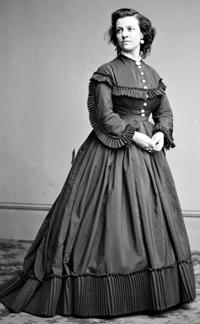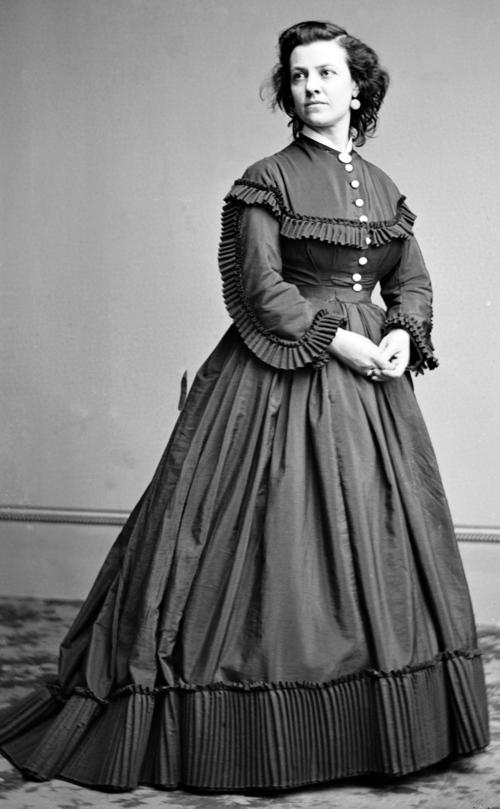Pauline Cushman was given the name Harriet Wood at the time of her birth, which she said occurred in New Orleans on June 10, 1833.
At age 18 she headed for the New York stage and enjoyed a degree of success. The young actress was described as having a “magnificent physique, large, lustrous slow black eyes, raven ringlets falling almost to her waist, with a profile of a Madonna and a voice as melodious as a lute.”
In 1853, Pauline married musician Charles Dickinson and the couple settled in Cleveland, Ohio. At the outbreak of the Civil War, her husband joined the Union Army and died in 1862. Pauline returned to the stage.
In 1863 while touring with an acting company in Louisville, Kentucky, she was approached by Southern sympathizers to propose a toast to the Confederacy while on stage.
An avid Unionist, she reported the incident to Federal authorities who convinced her she could help the Northern cause by portraying herself as a Confederate patriot. Singing the praises of Jefferson Davis in her speech, she was immediately fired from the acting company.
Pauline took on her most challenging role as a spy for the Union Army, stealing documents off the desks of enamored generals and copying maps of troop movements. Eventually captured and brought to trial, she was found guilty and sentenced to hang. Union troops swooped in and rescued her.
Her heroism made headlines, putting Pauline back on stage to tell her tale of espionage and bravery. Whether U.S. President Abraham Lincoln actually awarded her the designation of “Major” remains speculative, but she enjoyed the title and used it the rest of her life.
She headed west to tell of her adventures on stage and married again in 1872 in San Francisco, but became a widow for a second time two years later.
Eventually, people tired of her story and Pauline found herself working as a boardinghouse cook and maid, earning the reputation as a hard-talking, fast-swinging woman. She horsewhipped one man who spread false rumors about her, and threw hot soup on another who would not leave her alone.
Sometime around 1876 she met miner and businessman Jeremiah (Jere) Fryer, 15 years her junior. Fryer was on his way to Casa Grande as he had heard the railroad would soon be coming through that part of the desert. He and Pauline married in Florence on Jan. 29, 1879.
By May the Southern Pacific Rail line was stopping in Casa Grande and the Fryer boardinghouse was one of the few places passengers could find a place to sleep and a bite to eat. By 1880, the hotel was considered the best and largest in the area.
Jere, however, preferred to spend his time in a local saloon as he had a roving eye for the ladies. One of these women set upon Pauline one day and started a melee that left both ladies battered and bruised with Pauline getting the worst of the battle.
Afraid of losing her husband, she told Jere she was pregnant and wanted to have the baby in San Francisco since health care in Casa Grande was too primitive for her delicate condition.
In reality, Pauline persuaded an unwed expectant woman to have her baby in California with Pauline agreeing to adopt the child.
Baby Emma Pauline Fryer was born in San Francisco on Nov. 15, 1881, and Pauline returned to Casa Grande with her new daughter.
Throughout her short life Emma suffered from a nervous disorder that twisted her body into spasms and left her limp and unresponsive.
In 1882, Jere was hired as the first postmaster of Casa Grande and held several other positions in Pinal County government.
Pauline became a leading figure in Casa Grande society, although her interpretation of refinement meant that everyone behaved or she would “crack them over the head with her six-gun, a bottle, or anything else that was handy.”
Jere Fryer became sheriff of Pinal County in 1887 and moved his family to the county seat in Florence while leasing their boardinghouse in Casa Grande.
That summer Pauline took Emma to Michigan as a respite from the Arizona heat and to visit friends. On their return, they stopped in Nebraska where, on April 17, 1888, 6-year-old Emma died from a seizure.
Emma’s birth mother confronted Pauline about the untimely death of her daughter, and it did not take long for Jere to discover he was not Emma’s biological father. The couple separated.
Pauline kept the Casa Grande Hotel, refurbishing the rooms and building a veranda.
Advertising her hotel as “new and excellent accomodations” (sic) … with “baths, hot and cold,” she assured her guests that “attendants will be at each train. All stages stop at the door.”
The Arizona Weekly Enterprise reported, “Her house is eloquently furnished throughout and the accommodations provided are equal to any in the Territory not even excepting Tucson.”
Despite the success of her hotel, Pauline leased out the boardinghouse in December 1889 and by the following June she was gone.
Eventually settling in San Francisco, she toiled at menial jobs before moving to El Paso in 1892 to work as a dressmaker.
She was back in San Francisco by early the next year subsisting on a small military pension from her first husband’s enlistment in the Union Army.
Pauline Cushman died a pauper on Dec. 2, 1893. Reports stirred that she had committed suicide but the coroner ruled her death accidental from an overdose of prescribed morphine.
“Her room was neat,” said the San Francisco Daily Report obituary, “but there was an air of poverty about it, which bore out the statement of her friends that her only income was the Government pension.”
When the Women’s Relief Corps learned Pauline was to be buried in San Francisco’s Potter’s Field, they ordered a flag draped over her coffin as befitted a “Major” in the military.
Several years later she was reinterred in the Presidio National Military Cemetery in San Francisco, home to many of the country’s unsung heroes.





